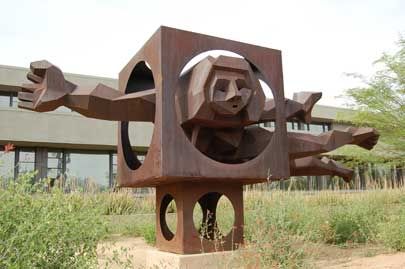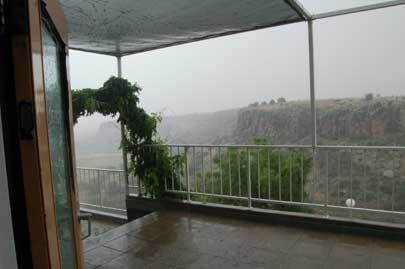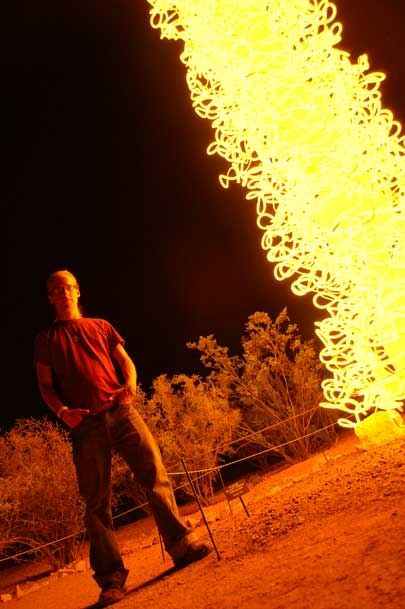
I had another interview with Stephan today, our French documentarian. I'm always interested in giving a fellow videographer/artist some good material to work with, so I sometimes may give more complicated, lengthy answers to otherwise simple questions.
One particular question caused me to go into a certain area of my life that I have not mentioned yet on this blog—namely, my fluctuating identity as a Christian/Agnostic, and the influence Arcosanti has had on this identity. Since this aspect of my life will sometime this year be broadcasted across Europe, I figured I should at least give the readers of this blog a preemptive reading, so that they don't have to find out about it on DVD.
I have only mentioned on occasion to people here at Arcosanti that I have a deeply religious background, and even in those conversations the depth of that sea may not be fully measured (maybe measurable—even I sometimes gloss over it like it's a backyard pool, rather than roaring, distant ocean).
More than just a religious background that I later rebelled against, I could be classified as a "Church Exile"—a little-known category of ex-Churchgoers, but not necessarily ex-Christians. This includes my immediate family (I have no siblings), and we all worked in the ministry in one form or another. Dad was a Music Pastor since I was a toddler (or music director depending on the denomination), and Mom's online multimedia service is to this day targeted to Churches. I attended a Protestant Christian elementary and middle school in southern Florida, but a public high school and, later, a very "secular" fine arts school.
To cut a very long story short over the course of three family moves (from Canada to Florida to Maryland), uncountable discussions, a lot of personal transformations, and maybe a few intangible injuries along the way, we became convinced that the bureaucratic, systematized nature of an institutional Church and its theology was at odds with the actual teachings of Jesus. Maybe that's too fine a point—I only want to speak for myself on this matter, and not my family. But either way, at this realization, and with all the situations that led up to its formation, we decided to leave the Church, with no set date on when we'd return, either within the ministry itself or just as simple attendees.
This was approximately four years ago. My journey in this matter has been different, dare I say more formative for me, than my parents. In many ways, if you gave me a multiple-choice test to determine my spiritual/religious beliefs, I would probably come out as an agnostic, maybe an atheist (if it was a bad day). I should be thankful to have the tact to say, and believe, that I often try to turn my back on this Christian heritage, but know that such an act is futile. Brian McLaren, a well-known Christian speaker, writer, and once-pastor, once said to me that the gospel was "deep in [my] bones". That was around when I was around fifteen. Years later, I would be fooling myself if I thought, even now, that I could separate the teachings of the Nazarene from my beliefs, however you want to classify them, like I could the calcium from my skeleton. But I read the Tao te Ching now more than I do the Gospel of John. I find more comfort and lessons in Zen than I do Psalms or Paul's letters to the Mediterranean churches, which for me are so old and dusty from a life gone past, with maybe a bit of bitterness from what they once meant and how they were abused by others, that they ring hollow, if not simply irrelevant to my current aspirations and life.
But it was Paolo Soleri who not two days ago said "we always return to our origins" in answer to a question of mine at School of Thought. Granted, he meant Hydrogen—but I was thinking of a different kind of origin.
Everyone's beliefs evolve and change as they grow older. It's natural to rebel against your heritage, if for a time—only to come back to it again once you're wiser about it. And this was the answer I gave to Stephan in his to-be documentary.
There is a very odd, but distinct similarity between the churches of my youth and Arcosanti. I like to call them "ideologically-centered communities." Put it this way—both Arcosanti and a church, for example, are held together not by profitmaking or livelihoods, but by belief in a cause. This cause does not have to be religious. But whatever this cause is, it is optimistic—it may have some degree of spirituality (not because it is divine, but because it cultivates the human spirit), and it creates a lot of friction. Friction, because everyone wants to contribute to a communal effort with all that they have—and not everyone may agree to how those efforts should be synthesized into a whole. This creates politics. But it is a good kind of politics—it is the most healthy kind, because it is (usually, hopefully) a selfless kind of politics.
Before coming to Arcosanti I was secluded to my parents basement—at not fault to them. If anything, a fault of mine for not "going out and getting a job"—which, to my credit was really less practical than it was appealing or "normal" (and I did get a job). But it was the social aspect that affected me, and in a larger sense of identity than loneliness (I am an extreme introvert, so loneliness is a gift usually, rather than a plague). It was the lack of a community that cultivated the spirit that was lacking. And, now that I think of it, I think that is the "hole in one's heart" that Evangelicals appeal to in unconverted people—not knowing that it is the binding community of the church that heals them, rather than its doctrine and theology.
Despite my agnostic stance, or maybe veneer, I actually tried going back to our old Church back in February. It didn't stick. I was in a community up in Baltimore that was post-denominationally Christian, but I was landlocked from Baltimore after college. I knew that I needed a community of friends and common believers—but I could not believe the same things that my old churchgoing friends did—and even if I could, I was too much of a philosopher and skeptic to believe it consistently, like a good little "saved" person.
This was one of the reasons I came to Arcosanti, and why I feel so comfortable here. It is ironic—that a desert community built by an atheist would feed the spiritual and communal needs of a post-Christian psuedo-agnostic. But it fit. The community here is searching after something, and they're all doing it in their own unique, differing ways—and that is the glue that holds it together. Soleri's architecture and passion for "curing" urban sprawl is only a loose focusing lens. Arcosanti does not have a mission statement or 10 points of unequivocal doctrine. If Soleri is a spiritualist, he believes in the possibility of a God in the far future, which may be in the process of retroactive self-creation (that's how I interpret his "Mystero Tremendo"). There may be a God, but not yet. That
possibility, yet undefined nature of the divine turns the orbit of this community on an interesting path. Out of a million chances, perhaps, it happens to be the right trajectory for me, a wayward comet, to fall in step with and be nurtured by this gas giant of vision that has a very small solid core of concrete and clay.
It is funny to think that most Evangelicals need, and say other humans need stability. I need stability, yes—but a kind that can allow the consistent (inconsistent) nature of instability to invade my life and propel me forward—the ability to change and evolve. It is only by walking forward, by evolving, that we come back to our origins, and that much wiser.
So all this I spilled out to Stephan's camera this morning—perhaps in a much more succinct way. But no less integral, or vulnerable, when speaking about my experience here.
I do not know what the future brings. These formative experiences set me on a path I can not fathom, especially when I am in the throes of it. But perhaps I don't need to run anymore. The refusal of what we
are is the "perception of manifestations, promulgated by our desires," as the Tao teaches. And it is what this place teaches, even if it comes only to the issues of human evolution and urban planning. But if that place of origin is an immeasurable sea, at least I can be content that I am at a place where I can grow in the (im)possibility of life and God, of virtue and gross humanity, of simplicity and optimistic vision, all in the face of oppressing reality. We are not playthings of our heritage—we are heirs to it, and we do with it as we see fit. We engage with it, and more. We are forged with it and it is in us—we just oftentimes forget that it is as living and breath-filled as we are.










